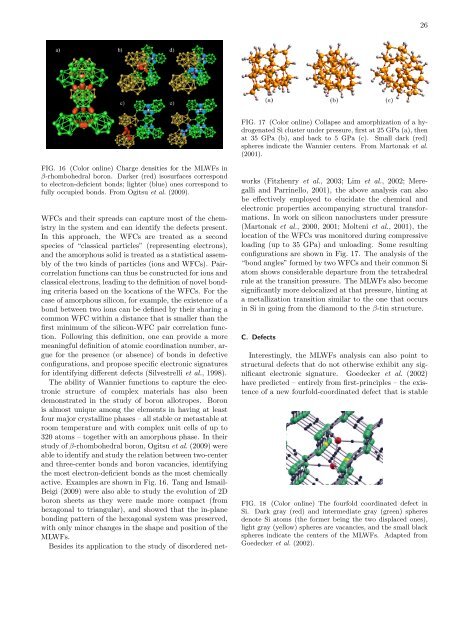Maximally localized Wannier functions: Theory and applications
Maximally localized Wannier functions: Theory and applications
Maximally localized Wannier functions: Theory and applications
Create successful ePaper yourself
Turn your PDF publications into a flip-book with our unique Google optimized e-Paper software.
26<br />
FIG. 17 (Color online) Collapse <strong>and</strong> amorphization of a hydrogenated<br />
Si cluster under pressure, first at 25 GPa (a), then<br />
at 35 GPa (b), <strong>and</strong> back to 5 GPa (c). Small dark (red)<br />
spheres indicate the <strong>Wannier</strong> centers. From Martonak et al.<br />
(2001).<br />
FIG. 16 (Color online) Charge densities for the MLWFs in<br />
β-rhombohedral boron. Darker (red) isosurfaces correspond<br />
to electron-deficient bonds; lighter (blue) ones correspond to<br />
fully occupied bonds. From Ogitsu et al. (2009).<br />
WFCs <strong>and</strong> their spreads can capture most of the chemistry<br />
in the system <strong>and</strong> can identify the defects present.<br />
In this approach, the WFCs are treated as a second<br />
species of “classical particles” (representing electrons),<br />
<strong>and</strong> the amorphous solid is treated as a statistical assembly<br />
of the two kinds of particles (ions <strong>and</strong> WFCs). Paircorrelation<br />
<strong>functions</strong> can thus be constructed for ions <strong>and</strong><br />
classical electrons, leading to the definition of novel bonding<br />
criteria based on the locations of the WFCs. For the<br />
case of amorphous silicon, for example, the existence of a<br />
bond between two ions can be defined by their sharing a<br />
common WFC within a distance that is smaller than the<br />
first minimum of the silicon-WFC pair correlation function.<br />
Following this definition, one can provide a more<br />
meaningful definition of atomic coordination number, argue<br />
for the presence (or absence) of bonds in defective<br />
configurations, <strong>and</strong> propose specific electronic signatures<br />
for identifying different defects (Silvestrelli et al., 1998).<br />
The ability of <strong>Wannier</strong> <strong>functions</strong> to capture the electronic<br />
structure of complex materials has also been<br />
demonstrated in the study of boron allotropes. Boron<br />
is almost unique among the elements in having at least<br />
four major crystalline phases – all stable or metastable at<br />
room temperature <strong>and</strong> with complex unit cells of up to<br />
320 atoms – together with an amorphous phase. In their<br />
study of β-rhombohedral boron, Ogitsu et al. (2009) were<br />
able to identify <strong>and</strong> study the relation between two-center<br />
<strong>and</strong> three-center bonds <strong>and</strong> boron vacancies, identifying<br />
the most electron-deficient bonds as the most chemically<br />
active. Examples are shown in Fig. 16. Tang <strong>and</strong> Ismail-<br />
Beigi (2009) were also able to study the evolution of 2D<br />
boron sheets as they were made more compact (from<br />
hexagonal to triangular), <strong>and</strong> showed that the in-plane<br />
bonding pattern of the hexagonal system was preserved,<br />
with only minor changes in the shape <strong>and</strong> position of the<br />
MLWFs.<br />
Besides its application to the study of disordered net-<br />
works (Fitzhenry et al., 2003; Lim et al., 2002; Meregalli<br />
<strong>and</strong> Parrinello, 2001), the above analysis can also<br />
be effectively employed to elucidate the chemical <strong>and</strong><br />
electronic properties accompanying structural transformations.<br />
In work on silicon nanoclusters under pressure<br />
(Martonak et al., 2000, 2001; Molteni et al., 2001), the<br />
location of the WFCs was monitored during compressive<br />
loading (up to 35 GPa) <strong>and</strong> unloading. Some resulting<br />
configurations are shown in Fig. 17. The analysis of the<br />
“bond angles” formed by two WFCs <strong>and</strong> their common Si<br />
atom shows considerable departure from the tetrahedral<br />
rule at the transition pressure. The MLWFs also become<br />
significantly more de<strong>localized</strong> at that pressure, hinting at<br />
a metallization transition similar to the one that occurs<br />
in Si in going from the diamond to the β-tin structure.<br />
C. Defects<br />
Interestingly, the MLWFs analysis can also point to<br />
structural defects that do not otherwise exhibit any significant<br />
electronic signature. Goedecker et al. (2002)<br />
have predicted – entirely from first-principles – the existence<br />
of a new fourfold-coordinated defect that is stable<br />
FIG. 18 (Color online) The fourfold coordinated defect in<br />
Si. Dark gray (red) <strong>and</strong> intermediate gray (green) spheres<br />
denote Si atoms (the former being the two displaced ones),<br />
light gray (yellow) spheres are vacancies, <strong>and</strong> the small black<br />
spheres indicate the centers of the MLWFs. Adapted from<br />
Goedecker et al. (2002).













